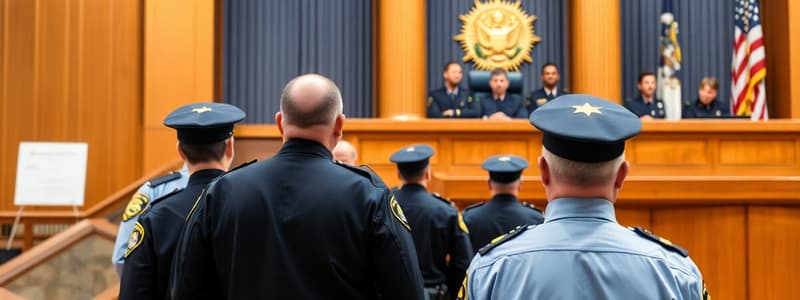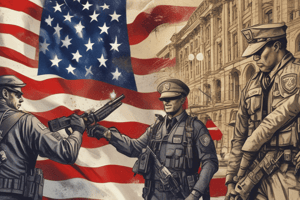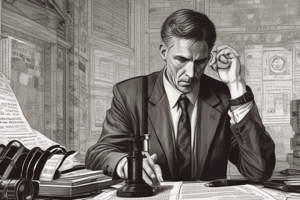Podcast
Questions and Answers
What is a key benefit of including procedural justice in law enforcement duties?
What is a key benefit of including procedural justice in law enforcement duties?
- Higher rates of compliance from the public (correct)
- Increased revenue for the department
- Less need for training on law enforcement practices
- Reduced workloads for officers
Which pillar emphasizes the need for fairness in decision-making?
Which pillar emphasizes the need for fairness in decision-making?
- Fairness and consistency of rule application (correct)
- Transparency and openness of the process
- Impartiality and unbiased decision-making
- Voice and representation in the process
What does the 'E' in the LEED framework stand for?
What does the 'E' in the LEED framework stand for?
- Equity (correct)
- Ethics
- Empathy
- Efficiency
Which of the following best describes procedural justice?
Which of the following best describes procedural justice?
How can law enforcement officers practice the 'Listen' aspect of the LEED framework?
How can law enforcement officers practice the 'Listen' aspect of the LEED framework?
Which of the following is NOT one of the four pillars of procedural justice?
Which of the following is NOT one of the four pillars of procedural justice?
What impact does procedural justice have on community interactions?
What impact does procedural justice have on community interactions?
Which aspect of procedural justice involves making decisions based on relevance and data?
Which aspect of procedural justice involves making decisions based on relevance and data?
What is unbiased policing primarily focused on?
What is unbiased policing primarily focused on?
Which of the following best defines explicit bias?
Which of the following best defines explicit bias?
What influences the development of implicit bias in individuals?
What influences the development of implicit bias in individuals?
Why is understanding implicit bias critical for law enforcement officers?
Why is understanding implicit bias critical for law enforcement officers?
What is one of the key components of unbiased policing?
What is one of the key components of unbiased policing?
What does implicit bias mean in the context of policing?
What does implicit bias mean in the context of policing?
How can law enforcement officers counter the effects of implicit bias?
How can law enforcement officers counter the effects of implicit bias?
Which misconception can arise when discussing biased policing?
Which misconception can arise when discussing biased policing?
What is the primary responsibility of law enforcement agencies?
What is the primary responsibility of law enforcement agencies?
Which component of the criminal justice system is NOT one of the main three components?
Which component of the criminal justice system is NOT one of the main three components?
What type of law enforcement agency is responsible for overseeing the county jail?
What type of law enforcement agency is responsible for overseeing the county jail?
Which of the following correctly describes federal law enforcement agencies?
Which of the following correctly describes federal law enforcement agencies?
County jails serve which of the following purposes?
County jails serve which of the following purposes?
What is the correct order of the levels of law enforcement agencies in the United States from lowest to highest jurisdiction?
What is the correct order of the levels of law enforcement agencies in the United States from lowest to highest jurisdiction?
What role do state law enforcement agencies have?
What role do state law enforcement agencies have?
Which statement accurately describes the corrections system?
Which statement accurately describes the corrections system?
What is a common health-related consequence of unaddressed routine stress?
What is a common health-related consequence of unaddressed routine stress?
Which of the following is NOT a typical job performance-related stress response?
Which of the following is NOT a typical job performance-related stress response?
What should law enforcement officers monitor in themselves and their peers?
What should law enforcement officers monitor in themselves and their peers?
What is a major risk associated with long-term stress for law enforcement officers?
What is a major risk associated with long-term stress for law enforcement officers?
Why is it important for officers to reach out for professional help when experiencing stress?
Why is it important for officers to reach out for professional help when experiencing stress?
Which factor increases the likelihood of chronic health problems in law enforcement officers?
Which factor increases the likelihood of chronic health problems in law enforcement officers?
What can be a sign of stress in law enforcement officers?
What can be a sign of stress in law enforcement officers?
How does trauma affect law enforcement officers on a biological level?
How does trauma affect law enforcement officers on a biological level?
How does empathy contribute to maintaining safety during police encounters?
How does empathy contribute to maintaining safety during police encounters?
What important behavior should officers exhibit to demonstrate courtesy?
What important behavior should officers exhibit to demonstrate courtesy?
What is one suggested practice that reinforces empathy during police encounters?
What is one suggested practice that reinforces empathy during police encounters?
Why is it essential for officers to treat every person they meet with dignity and respect?
Why is it essential for officers to treat every person they meet with dignity and respect?
What can empathy help achieve in interactions involving law enforcement?
What can empathy help achieve in interactions involving law enforcement?
How should officers react when faced with unrealistic requests from individuals?
How should officers react when faced with unrealistic requests from individuals?
What role does professionalism play in law enforcement interactions?
What role does professionalism play in law enforcement interactions?
What effect does an empathetic approach have on the behavior of individuals during police encounters?
What effect does an empathetic approach have on the behavior of individuals during police encounters?
What might be a reason Officer Hernandez's colleagues reacted negatively to his decision to seek therapy?
What might be a reason Officer Hernandez's colleagues reacted negatively to his decision to seek therapy?
Which of the following is NOT mentioned as a way to manage physical health for stress reduction?
Which of the following is NOT mentioned as a way to manage physical health for stress reduction?
What is meant by resilience in the context of law enforcement?
What is meant by resilience in the context of law enforcement?
Why is it important for law enforcement officers to have a support system?
Why is it important for law enforcement officers to have a support system?
What lifestyle change is suggested to help reduce stress?
What lifestyle change is suggested to help reduce stress?
What is the role of Employee Assistance Programs (EAP) for officers?
What is the role of Employee Assistance Programs (EAP) for officers?
Which dietary practice is encouraged for maintaining health in law enforcement?
Which dietary practice is encouraged for maintaining health in law enforcement?
What does establishing a balanced work and home life help with?
What does establishing a balanced work and home life help with?
Flashcards
Criminal Justice System Components
Criminal Justice System Components
The system that maintains and enforces criminal laws, including law enforcement, courts, and corrections.
Local/Municipal Law Enforcement
Local/Municipal Law Enforcement
Enforces local ordinances and state laws within their jurisdiction, like police and public safety departments.
Law Enforcement Levels
Law Enforcement Levels
Four levels of law enforcement: local/municipal, county, state, and federal.
County Law Enforcement
County Law Enforcement
Signup and view all the flashcards
State Law Enforcement
State Law Enforcement
Signup and view all the flashcards
Federal Law Enforcement
Federal Law Enforcement
Signup and view all the flashcards
County Jails
County Jails
Signup and view all the flashcards
Corrections System
Corrections System
Signup and view all the flashcards
Procedural Justice
Procedural Justice
Signup and view all the flashcards
Fairness and Consistency
Fairness and Consistency
Signup and view all the flashcards
Voice and Representation
Voice and Representation
Signup and view all the flashcards
Transparency and Openness
Transparency and Openness
Signup and view all the flashcards
Impartiality and Unbiased Decision-Making
Impartiality and Unbiased Decision-Making
Signup and view all the flashcards
LEED Framework
LEED Framework
Signup and view all the flashcards
Listen (LEED)
Listen (LEED)
Signup and view all the flashcards
Explain (LEED)
Explain (LEED)
Signup and view all the flashcards
Bias in policing
Bias in policing
Signup and view all the flashcards
Unbiased policing
Unbiased policing
Signup and view all the flashcards
Explicit Bias
Explicit Bias
Signup and view all the flashcards
Implicit Bias
Implicit Bias
Signup and view all the flashcards
Impact of implicit bias
Impact of implicit bias
Signup and view all the flashcards
Eliminating implicit bias
Eliminating implicit bias
Signup and view all the flashcards
Consequences of Bias
Consequences of Bias
Signup and view all the flashcards
Fair and impartial Policing
Fair and impartial Policing
Signup and view all the flashcards
Trauma's impact on the brain
Trauma's impact on the brain
Signup and view all the flashcards
Acute stress
Acute stress
Signup and view all the flashcards
Routine stress
Routine stress
Signup and view all the flashcards
Stress effects on relationships
Stress effects on relationships
Signup and view all the flashcards
Long-term stress responses
Long-term stress responses
Signup and view all the flashcards
Law enforcement stress risks
Law enforcement stress risks
Signup and view all the flashcards
Stress indicators
Stress indicators
Signup and view all the flashcards
Stress coping mechanisms
Stress coping mechanisms
Signup and view all the flashcards
Officer Hernandez's colleagues' reaction
Officer Hernandez's colleagues' reaction
Signup and view all the flashcards
Why is self-care essential for law enforcement?
Why is self-care essential for law enforcement?
Signup and view all the flashcards
What are some ways to maintain physical health?
What are some ways to maintain physical health?
Signup and view all the flashcards
How can staying active outside of work benefit officers?
How can staying active outside of work benefit officers?
Signup and view all the flashcards
What is a support system in law enforcement?
What is a support system in law enforcement?
Signup and view all the flashcards
What is resilience in law enforcement?
What is resilience in law enforcement?
Signup and view all the flashcards
How to build resilience?
How to build resilience?
Signup and view all the flashcards
Employee Assistance Program (EAP)
Employee Assistance Program (EAP)
Signup and view all the flashcards
Empathy
Empathy
Signup and view all the flashcards
Empathy and Procedural Justice
Empathy and Procedural Justice
Signup and view all the flashcards
Courtesy
Courtesy
Signup and view all the flashcards
Professionalism
Professionalism
Signup and view all the flashcards
Building Rapport
Building Rapport
Signup and view all the flashcards
Avoiding Barriers in Communication
Avoiding Barriers in Communication
Signup and view all the flashcards
Redirect Focus
Redirect Focus
Signup and view all the flashcards
Professional Demeanor
Professional Demeanor
Signup and view all the flashcards
Study Notes
Criminal Justice System Structure
- The US criminal justice system comprises law enforcement, courts, and corrections.
- Law enforcement enforces laws, maintains order, and protects constitutional rights.
- Courts interpret laws.
- Corrections enforces punishment and rehabilitation as defined by the courts.
Levels of Law Enforcement
- Four levels exist: local/municipal, county, state, and federal.
- Each enforces laws within its defined jurisdiction.
- Local/municipal enforces city ordinances and state laws within their area.
- County enforces county ordinances and state laws, manages the county jail, and handles civil matters.
- State agencies enforce state laws across the state.
- Federal agencies enforce federal laws nationally.
Corrections Systems
- County jails hold arrestees awaiting trial or serving less than a year of detention.
Procedural Justice
- Procedural justice focuses on fair and equitable application of justice.
- Perceived fairness is crucial, not just outcomes.
- Consistency in decision-making and respectful treatment are key.
- Involves individuals in decisions affecting them and listens to concerns.
- Transparency and openness in decision-making processes are essential.
- Impartial decisions based on evidence and data are necessary.
- The LEED framework (Listen, Explain, Equity, Dignity) helps in practice.
Unbiased Policing
- Bias is unethical unfair treatment.
- Unbiased policing treats all individuals equally, regardless of demographics.
- Decisions in unbiased policing are based on evidence and data, not emotions or stereotypes.
- Explicit bias involves conscious dislike of groups.
- Implicit bias is unconscious prejudice.
Trauma Impact
- Traumatic stress is a normal response to difficult experiences, not personal failure.
- Routine/acute stress can also negatively impact lives.
- Acute/routine stress impacts anxiety, tension, irritability.
- Health-related signs include headaches, blood pressure changes, sleep loss.
- Job performance is affected by decreased productivity and consistency.
- Personal relationships may suffer.
- Long-term effects include depression, suicidal thoughts, and chronic illnesses.
- Law enforcement has a higher risk of these conditions, suicide, and substance misuse.
Stress Management and Resilience
- Prioritizing mental and physical well-being is crucial for officers.
- Maintaining healthy lifestyle choices (exercise, sleep, diet) significantly reduce stress.
- Creating a support system (professional, personal) and a life outside of work is important.
- Resilience is the ability to effectively cope with stress and trauma.
- Building resilience involves prioritizing health, seeking support, and connecting with others.
Empathy and Communication
- Empathy is emotional connect with another person.
- Empathy allows understanding of another's feelings and situations.
- Empathy improves communication and de-escalation of situations.
Courtesy and Professionalism
-
Courtesy involves professional conduct and a respectful demeanor.
-
Being personal yet professional (using names) and treating everyone with dignity builds rapport.
-
Avoiding sarcastic language ("obviously") or divisive language ("you people") is vital.
-
When addressing unrealistic requests, focus on what can be done, and explain actions and reasons.
-
Maintaining courtesy enhances public cooperation.
-
Professionalism involves demonstrating good character and pride in one's career.
Studying That Suits You
Use AI to generate personalized quizzes and flashcards to suit your learning preferences.




